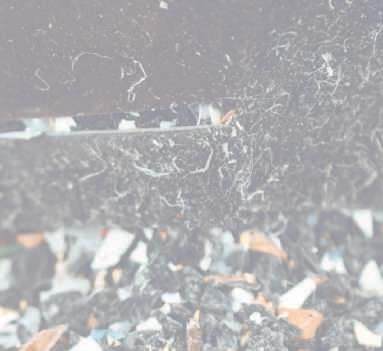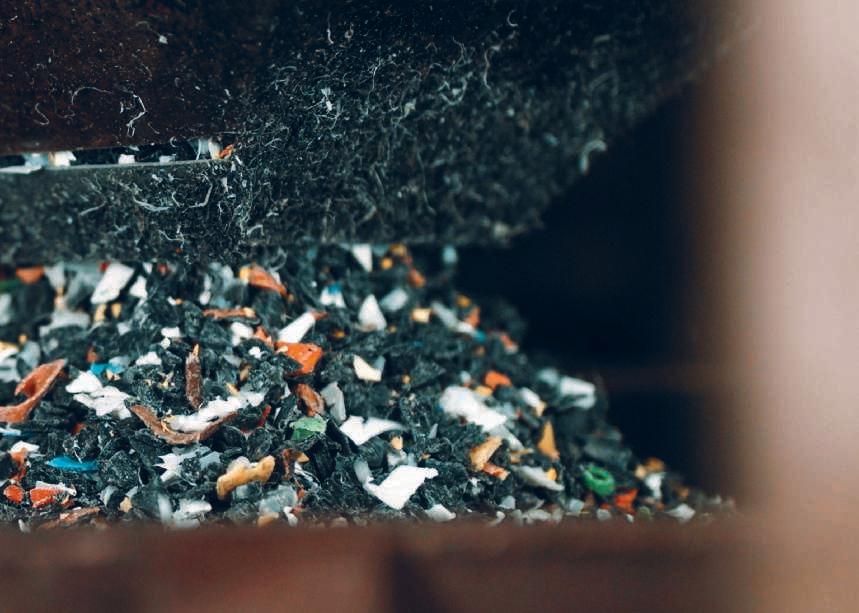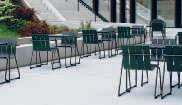PLANETARY PLASTIC PAVILION PLASTIC




































Planetary Plastic Pavilion
Published: September 2022
Text and layout: Smith Innovation
Translation: Anne Christine Hanson
Photos: Plastindustrien
Published by: Plastindustrien
Design og medieproduktion: Kailow A/S, CSR-, miljø- og arbejdsmiljøcertificeret
Smith Innovation
Frederiksholms Kanal 30A
1220 Copehagen K
www.smithinnovation.dk
18 #1 How do we do away with the culture of perfectionism in plastics – how can we make recycling a beautiful experience?
20 #2 Where are the big market opportunities for using recycled plastics of mixed quality?
22 #3 How can suppliers of plastic products get into the game early on?
24 #4 Where and how can we increase the use of plastics to replace CO2 burdensome materials such as aluminum and steel in building structures?
26 #5 How can we make plastic solutions that are easier to recycle, either because they can be reused 1:1, consist of a uniform material or can be disassembled?
28 #6 How can we make it easier to handle various fractions from construction sites so that all waste does not end up in the same container?
30 Figure: The relationship between handling returnable waste and own production.
32 #7 How can we boost the willingness to pay for sustainable solutions, and how should they be priced initially so that demand increases without bleeding the business?
34 #8 How can the properties of plastic be used to advance sustainable transformation through e.g., “tiny living” or renovating existing building stock?
36 #9 How do we ensure uniform and comprehensive benchmarks so that the most sustainable solution is chosen?
38 #10 How can production be transformed to cope with quality variations in recycled plastics and to enable smaller runs that match the recycling volume available?
3 Planetary Plastic Pavilion | Innovation Strategy CONTENTS 5 Foreword 6 Introduction
Part 1: Vision and
Principles
Vision
Dilemmas
Part 2: Vision og
of
8
Innovation
10
12
14
Innovation Challenges 16 Summary
innovation challenges





4
Planetary Plastic Pavilion | Innovation Strategy
FOREWORD
As the trade association for Danish plastics companies, it is only natural that the Danish Plastics Federation work to promote a sustainable and future-forward use of plastic. And part of this is to accelerate the development between actors with a particular interest in, and knowledge about, the sustainable use of plastics in the building and construction sector.
This is why we have taken the initiative for this publication. In it, we pencil out a road map of challenges that must be solved in order to harness the full potential of plastics in the sustainable transformation of construction.
Our thanks go to the following companies which have generously shared their experiences and considerations regarding sustainable business models:
• Again
• BEWI
• Fiberline
• Kingspan
• PRIMO
• SP Moulding
• Velux
This publication would not have been possible without you. Naturally, we take responsibility for its written contents.
We have chosen to call the publication Planetary Plastic Pavilion. Because ultimately, this is the goal - that we build a planet that is in balance. That by using plastics intelligently, we can not only house the generations of today, but also the generations of tomorrow.
As it is mentioned in the introduction, common challenges demand common solutions. It is our hope that this publication inspires an informed and solutionoriented dialogue on the key role plastic plays in a sustainable future for us all.
We hope you enjoy reading the publication. And most of all, that it inspires you.
Plastindustrien
The Danish Plastics Federation
Christina Busk and Rasmus Grusgaard
Planetary Plastic Pavilion | Innovation Strategy 5
INTRODUCTION
When we think about a good future, fossil solutions have moved from being on the right side to being on the wrong side of the equation. Over the past few hundred years, access to abundant energy resources and a range of new materials, plastics in particular, has created prosperity and increased opportunities for billions of people. But this has come at a price: increasing greenhouse gas emissions and a planet that is about to boil over and succumb as a result of human expansion. If we are to restore respect for our planet and its life-supporting systems in the atmosphere, the oceans and on land, fast and profound change is needed.
Plastic is a 100% synthetic material that consists of polymers. Polymers are very long molecules that can be produced cheaply and have properties that can be tailored to specific purposes. Plastic got its name from the material’s plasticity and malleability. It is precisely this easy malleability that is the common feature of plastic materials and the reason for its widespread distribution. Polymers can occur naturally (as in e.g., rubber), but most polymers today are manmade and primarily produced from oil and natural gas.
It is therefore not incorrect when plastics are linked to fossil solutions. And hence solutions which basically pull in the wrong direction when it comes to sustainability.
But this is not the whole truth either. Plastic is many things and can be made and used in many ways. The properties of plastics mean that processing the material, compared to many other materials in building and construction, can be done energyefficiently and with minimal waste. If used correctly, plastic reduces the combined consumption of CO2 in construction, either because it replaces more energy intensive materials, or because it improves on a product’s overall function. This could lead to less space-demanding insulation solutions, which means we could build fewer square meters, or build window frames with lower heat loss.
We live in an age where digital media forms public opinion and problems tend to be seen in terms of “either/or”. Either you are for plastic or against it. Many are against it. But it’s not quite that simple. If you are looking for an industry with a long-standing
6 Planetary Plastic Pavilion | Innovation Strategy
tradition for recycling, the plastics industry is a good place to start. Think only of drinking bottles and used piping. Plastic is relatively easy to recycle, and our greatest climate challenges are linked to our handling plastic incorrectly - not to the material itself.
But this does not mean plastic cannot be made significantly more sustainable. And maybe more importantly that the building sector as such can be made much more sustainable by using plastics more mindfully. Our current mode of producing, using and thinking about plastic is coming to an end, as is a fossil age that has had too little focus on the limits of our planet. If plastic is to be a partner and not an opponent in sustainable transformation, fundamental change is needed throughout the value chain, from raw materials to manufacturing to use and, ultimately, to the collection and recycling of plastic.
This is a technical challenge: How should we combine materials, and how should we produce them? It is also about cooperation and logistics: How do we get hold of plastic products at the end of their life cycle, and how should companies collaborate on collection
and equipment use that make recycling possible? And last but not least, the challenge is also about the expectations all of us as consumers have about materials and sustainability: How do we learn to perceive lack of uniformity in recycled plastics as an aesthetic quality rather than a defect? How can we increase our willingness to pay for 100% sustainability in recycling?
Common challenges demand common solutions. Even though today many companies and their clients are making progress, more joint cooperation and innovative thinking is needed. Hence this publication, which outlines a number of the all-important challenges faced in promoting the sustainable use of plastics in building and construction. Challenges we invite everyone to help solve. Especially future generations of craftsmen, architects and engineers.
Not only because it is the coming generations who will bear the full brunt of a planet out of balance. But also because there is a need for outside inspiration if the sector’s established players are to rethink plastic’s role in a world that no longer uses more than the planet can provide.
7 Planetary Plastic Pavilion | Innovation Strategy






PART
PART 1VISION AND INNOVATION PRINCIPLES






VISION
Introduction
The vision and task at hand is to build in a way that respects and sustains the circularity of our planet.
Plastic plays a key role in this enterprise. The material is widely used in building and construction because of its unrivalled technical properties. And the sector has come far in minimizing resource consumption and waste in connection with processing and recycling the material.
At the same time, it is a necessary part of the sustainable transition to rethink how we manufacture, use, recycle and think about plastic and plastic products. The figure on the right presents 10 key ways to promote the sustainable use of plastic in the future.
Planetary Plastic Pavilion | Innovation Strategy 10
appreciating variations in its appearance.


converting production so it can handle diverse qualities of recycled plastic and enable smaller runs that match the volume of recycled plastic available.
promoting sustainable use of plastic by thinking in recyclability early on in the design phase of the original product.
utilizing recycled plastic of mixed quality that is available cheaply in large quantities, and whose quality is good enough for certain structures (e.g., foundations).





replacing CO2-burdensome building materials (e.g., aluminum and steel) with plastic.
making documentation on climate impact easier to understand, so the benefits are clear to the end-user.
creating high-performance plastic materials that can reduce the number of m2 built or make renovations to existing buildings more affordable for end-users.
using products in building and construction that can be disassembled and reused – either as is or by recycling them back to their original material fractions.
improving possibilities for recovering plastic at later stages of the value chain, e.g., from construction sites and during demolition.
providing clarity and knowledge throughout the value chain about the costs and the pricing of recycled plastic.


Strategy 11
Planetary Plastic Pavilion | Innovation
We make it possible to build within the limits of our planet by… and pricing
DILEMMAS
The goal is simple: Absolute sustainability. The road to get there is bit more complicated. Our current use of plastic is the result of a number of factors and reasonable, well-founded considerations. The question thus becomes, how and to what extent we can maintain and strengthen what is good about plastic when sustainability has top priority. To the right, we have made a list of inherent dilemmas the industry must address and solve before environmental performance and technical performance can go hand in hand.
Today, plastic solutions are often made from several types of plastic in order to achieve a tailored performance. But monoplastic is easier to return and recycle. So how can we achieve better performance without mixing materials in a way that makes them impossible to separate again, or how can we make it possible to return mixed plastic to its original fractions, for instance, through separation and sorting?
Seen from the perspective of production and function, it is best to work with recycled plastic of a uniform
type. But this places huge demands on the collection and sorting of plastic, and as a result, the return quantities are often limited. So, when and for which purposes can it pay to utilize more mixed qualities collected in large volume?
Plastic manufacturers have the easiest time managing collection for recycling, for instance, by collecting the offcuts from source production. This is by far the easiest to do in your own factory. The next easiest is plastic collection by one of the few large buyers. The further along in the value chain, the more complicated the logistics. However, this is often where many materials end up. So how can we make it easier to ensure recycling collection out on construction sites, or when houses are renovated or demolished?
Despite high labor costs, it has been possible to keep plastic production in Denmark because of a highly efficient production system that can handle large volumes of material, most of which is welldefined. But recycled plastic is often more varied in quality, and the volume required for high-end products for specific end-users is not always large
enough to justify the conversion of an expensive production system. So how can we become better at manufacturing rationally on a small scale, and how can design and collection companies again get access to a domestic production capacity so they can collaborate on developing tomorrow’s plastic solutions?
Builders and end-users show great interest in sustainability. But they also make great demands that the solutions they choose are well-documented and reputable. How can we ensure peace of mind when choosing sustainable materials and new solutions?
New sustainable solutions are more expensive to manufacture than conventional solutions that have been optimized over the years. When sustainable solutions go up in volume, they become cheaper to produce. But how should new solutions be priced in the beginning? If prices are set too high, demand will be slow to get going. If set too low, companies will lose money and may not have the resources needed to take the solution all the way to market.
Planetary Plastic Pavilion | Innovation Strategy 12
Monosolutions that are easy to recycle

Large degree of sorting so plastic is uniform. (But expensive and small in
Plastic collected at first stage and from large manufacturers (so it is uniform)
Highly efficient production that is profitable even at Danish wage levels





Builders want sustainable solutions


The price of sustainability today (the actual price of a sustainable solution, meaning a price that covers all costs)




Composite solutions that have high performance


Small degree of sorting so the volume is large (but the quality mixed)




















Plastic collected at the second and third stages (so we get it all – also the plastic from construction sites and end-users)
Production capacity that makes it possible to produce smaller series and use recycled plastic of mixed quality and appearance








Builders want reputable, documented solutions that are not difficult to get permission to use
The price of sustainability tomorrow (the lowest price for a sustainable solution when volume comes up, and an introductory price that can get market demand started)

Planetary Plastic Pavilion | Innovation Strategy 13
PART






PART 2INNOVATION CHALLENGES






INTRODUCTION
Several sustainability challenges cut across the plastics industry and are difficult to solve for the individual company. Either because they demand too many resources. Or because development is dependent on many actors changing their behavior at the same time.
Based on our interviews, we have identified 10 key innovation challenges to the sustainable use of plastic that companies want addressed at industry level.
And that complement their own, local sustainability initiatives.
Each of the 10 innovation challenges are reviewed individually in the following pages.
The figure on the right shows the 10 challenges, which have been placed according to innovation type, namely:
• Development of new materials and how to use them in building and construction.
• Development in the ways plastic materials are produced and collected.
• Development in how plastic is sold and demand is created, and hence the criteria for choosing plastic solutions.
• Development in our overall perspective on plastic, and how we as consumers perceive and value quality in new, more sustainable materials.
In this way the figure illustrates that the sustainable transformation of plastic is about more than just the material itself.
It is also a re-thinking about the way plastic is produced, used, chosen and perceived which calls for an innovation effort that goes above and beyond what individual companies or customers can achieve on their own.
Planetary Plastic Pavilion | Innovation Strategy 16
INNOVATION CHALLENGES
Sustainability – the bigger picture
Perfectly imperfect
Material-driven design










ARCHITECTURE AND HOLISTIC PERSPECTIVE
When plastic is best
Made for disassembly
ENGINEERING AND MATERIALS DECISION-MAKING AND PRODUCTION PROCESS BUSINESS AND DEMAND


XL markets for mixed recycled plastic


When not everything is ”small combustibles”
Converting production
The price of sustainability
Count what counts


INNOVATION CHALLENGE #1
Perfectly imperfect
How
can we do away with the culture of perfection in plastics - how can using recycled plastic become something beautiful to experience?
How we as end-users read a material depends on context and our past experience. In a medical context, we associate plastic’s clear lines and clean, uniform surfaces with quality. When plastic is used visibly in construction, these same traits are often experienced as ”cold”. While we as end-users know that cardboard is often made from recycled paper, and that this is a good thing. We do not know that many plastic products are made out of recycled plastic. And therefore, we cannot appreciate the gray color that is the result when recycled plastic of different colors are mixed.
In a way, plastic solutions have undermined their own success. Customers have loved to demand perfection. And clever engineers and production workers have loved supplying it. We have become accustomed to optimized solutions that are identical in form, composition and finish. It is therefore hard to imagine it could be any other way.
In some cases, it has been possible to defeat this culture of perfection. And to take advantage of the functional and especially the aesthetic qualities that emerge when recycled materials are put together. The OC2 and R.U.M. furniture series from A:GAIN - both made from discarded plastic beer kegs - are prime examples of this. Here, Danish design, Danish production, storytelling and the visual expression of plastic come together to push the price up rather than pull it down.
Recycling has its own aesthetic. It matters how it looks recycled. When lifestyle objects such as lamps and kitchen furnishings are made using recycled plastic, they must not look too finished. For this reason, manufacturers must sometimes add an extra element to a product so it looks sustainable in the right way.
Key issues
• How can we increase the knowledge and appreciation of plastic solutions that are already made from recycled plastic today?
• How can we become better at understanding which contexts end-users perceive uniformity vs. variation as quality, and use this to become better at finding new applications for recycled plastic?
• How do we create an aesthetic understanding for plastics that are recirculated with minimal input of energy and new materials – including those that may not have the “right” recycled look?
Planetary Plastic Pavilion | Innovation Strategy 18
Example: A:GAIN bar series for Bella Center made of recycled plastic from used Carlsberg beer kegs. Denmark is a high-wage country and consequently local waste collection, transport, sorting, processing and production make it difficult for recycled end-products to compete on equal price terms with products made from virgin raw materials or from recycled plastic sourced from other, faraway countries. A:GAIN believes that upcycling should ideally take place as close to source as possible. They therefore work strategically with partners who view design and aesthetics as important factors for two reasons:

Perfectly imperfect
Material-driven design
Sustainability
When plastic is best
Made for disassembly
ARCHITECTURE AND HOLISTIC PERSPECTIVE ENGINEERING AND MATERIALS
XL markets for mixed recycled plastic

BUSINESS combustibles”
The price of sustainability
Count
Converting production
Customers take better care of beautiful, quality products so they last longer, which is sustainable.

Second, because the upcycled pellet itself cannot compete (enough) with a virgin pellet, the upcycled pellet must be elevated from being a resource to being a finished product. The garden furniture made with Mater Design and designed by Nanna Ditzel, as well as the R.U.M. chair series made with Wehler and designed by C.F. Møller are examples of this.The seats and slats of both chairs are produced at Letbek A/S.
Planetary Plastic Pavilion | Innovationsstrategi 19

– the bigger picture
DECISION-MAKING AND PRODUCTION AND DEMAND what counts
When not everything is ”small PROCESS
Example: Home accessories made from recycled plastic for muuto and Rosendahl. This example is a story of how aesthetic value is added to recycled plastic depending on where it is used. An unevenness has an aesthetic value that signals a climate-friendly creation or, conversely, is seen as a defect that speaks to sloppiness and mistakes during production.
INNOVATION CHALLENGE #2
XL markets for mixed recycled plastic
Where are the major market opportunities for recycled plastic of mixed qualities?
Plastic comes in countless variations, and there is a great interest in collecting and recycling as many fractions as possible. But as described under innovation challenge 10, this requires a major conversion effort, and small volumes and high prices are still obstacles to fully recycling all plastic materials.
But regarding large volumes – which have the greatest total impact - there are plenty of competitive opportunities for recycled plastic available today. Polyethylene is the most commonly produced type of plastic in the world. We are familiar with its hard and soft varieties from plastic bags, packaging, pipes and bottles, electrical appliances and a wide range of other everyday household items.
The big question is where this type of plastic –which cannot be sorted and recycled into highquality plastic, but is available in large volumes at a competitive price - can be used. In which contexts are its technical properties sufficient, and where is there a great potential demand that corresponds to the waste volume available?
Foundation solutions could be the perfect opportunity. They require large quantities of moisture-resistant
material and place no great demand with regard to appearance or a completely uniform quality. Foundations have always presented a bit of a challenge for sustainable construction. Durable concrete solutions are CO2-intensive. And organic materials, such as wood, do not hold up in the long run when they come into contact with soil. Using recycled plastic of mixed and lower quality would solve the waste problem and, used correctly, ensure durable, sustainable construction.
Key issues:
• Which application areas are there in the building and construction sector that can use large quantities of mixed quality plastic? For example, what opportunities are there in some of the upcoming infrastructure projects?
• How can we increase awareness about the quality and price of mixed plastic among builders, consultants and craftsmen?
• How can we incorporate a life cycle assessment - also for recycled plastic? What do we do with plastic used in a foundation when a house or a bridge is to be taken down?
Planetary Plastic Pavilion | Innovation Strategy 20
Sustainability – the bigger picture

Perfectly imperfect
Material-driven design
When plastic is best
Made for disassembly
ARCHITECTURE AND HOLISTIC PERSPECTIVE ENGINEERING AND MATERIALS
DECISION-MAKING AND PRODUCTION AND DEMAND
XL markets for mixed recycled plastic

The price of sustainability
PROCESS combustibles”
When not everything is ”small

Converting production
Planetary
Example: The total piping of all utility installations made for the off-shore industry (Primo).
Count what counts Plastic Pavilion | Innovationsstrategi 21
INNOVATION CHALLENGE #3
Material-driven design
How can the know-how of material manufacturers come into play early in the game?
Sustainability requires improvements at all stages of construction. No less between all stages of construction. This is especially evident when preparing environmental product declarations, when it is important to know and be able to document all the facts concerning environmental impact, from raw material to recycling.
No one knows more about the potential of plastic materials than the people who manufacture the materials. Even so, it is usually the client, such as a producer of building components that contain plastic, that determines how plastic is included in the finished product.
With sustainability at the top of the agenda, we need to turn the design process upside down. Put simply, we have been used to defining function and appearance first and then choosing a suitable material afterward. Today we need to start with function and material and work on visual appearance at a later stage. Sustainability starts with the material, which is why it is essential to incorporate the expertise of the material manufacturer at the earliest design stages. And sustainability ends with the material, which makes it essential that the knowhow of the supplier and recycling company come together.
In many cases, this is already happening. Window manufacturers, for one, collaborate closely with
selected plastic suppliers, involving them early on when developing new, more sustainable window series. But there is still a tendency for plastic suppliers mainly to impact decisions relating to the window parts they supply. Proposing solutions, for instance, that plastic is used to replace other nonplastic-based parts, is not easy when a supplier becomes involved in the design process.
Key issues:
• How can we increase knowledge about plastic’s technical and environmental properties among companies that design building materials that contain plastic?
• Which design tools and processes enable an increased adaption of materials knowledge at the earliest phases of design?
• How can close knowledge relationships be established between plastic suppliers and their customers – including small customers, and also when plastic volumes are small?
Planetary Plastic Pavilion | Innovation Strategy 22
Perfectly imperfect
Materialdriven design
Sustainability – the bigger picture
When plastic is best
Made for disassembly
ARCHITECTURE AND HOLISTIC PERSPECTIVE ENGINEERING AND MATERIALS
Example: A test area in a part of the Danish city Lemvig is supplied with waste water produced with a significant amount of recycled material, as well as district heating pipes made of 100 % recycled plastics. Behind the project is Klimatorium, Denmark's international climate center, Danva, Lemvig Vand, Danish Technological Institute, NPG Danmark, Wavin, Uponor, Emtelle and the Danish companies providing the recycled materials, Aage Vestergaard Larsen A/S and Plastix A/S.
DECISION-MAKING AND PRODUCTION AND DEMAND
BUSINESS combustibles”

When not everything is ”small XL markets for mixed recycled plastic for PROCESS

The price of sustainability
Converting production
Count what counts
Planetary Plastic Pavilion | Innovationsstrategi 23
INNOVATION CHALLENGE #4
When plastic is best
Where and how can plastic replace CO2 burdensome building materials?
Plastic is a component in many parts used in building and construction. At the same time, there are many application areas where it is not used - even though plastic-based solutions could easily replace other, more resource-demanding solutions.
Steel, concrete and aluminum are widely used materials for constructing load-bearing solutions, and aluminum is used when weather-resistance is required. In a number of cases, fiber-reinforced plastic is an ideal alternative - one that ensures the same function, but with a significantly lower CO2 footprint. In such cases, the implementation of a common European scale for calculating a building material’s sustainability profile could propel further development in this area and, at the same time, shed light on new application areas.
Another example – see also Innovation challenge #2 – is to use recycled plastic in foundation solutions, and in this way reduce the use of cement.
Development in substituting energy-intensive materials with less energy-intensive ones is already underway – helped along by rising energy prices.
But plastic manufacturers still face obstacles. When calculating jobs, it is easiest to overestimate size and choose uniform materials. A more differentiated and optimized use of materials requires extra effort, and consultants are not always paid for the time it takes to
do this. And it is easier and more comfortable to work with materials you already know - why replace them with something new when there is no pressure to do so?
Sustainability is about achieving the utmost function using as few resources as possible. And, ultimately, keeping within the resource limits set by our planet. If plastic is used in the right places and used correctly, it can play an important role as we continue to improve on this equation.
Key Issues
• In which areas of construction can plastic-based solutions be a substitute for more energyintensive materials?
• How can we ensure climate-friendly material substitutions - also when high energy prices are not a factor?
• How can we create incentives so builders, consultants and craftsmen choose solutions that are the most sustainable instead of those they are familiar with? How do we ensure that it is not only the building as a whole, but also its many sub-elements that are subject to high sustainability requirements?
Planetary Plastic Pavilion | Innovation Strategy 24
When plastic
Perfectly imperfect
ARCHITECTURE AND HOLISTIC PERSPECTIVE ENGINEERING AND MATERIALS
Example: Fiberline building and construction profiles that can replace steel and require less maintenance in severely wet environments.

DECISION-MAKING AND PRODUCTION AND DEMAND
PROCESS
for

BUSINESS combustibles”
When not everything is ”small XL markets for mixed recycled plastic
Material-driven design Made for disassembly Converting production The price of sustainability
Example: Kamstrup metering solutions made from plastic. The product is inexpensive to produce, does not corrode and, unlike brass, no one wants to steal it because of its low material value.

Sustainability – the bigger picture Count what counts
Planetary Plastic Pavilion | Innovationsstrategi 25
INNOVATION CHALLENGE #5
Made for disassembly
How do you make plastic solutions that are easier to recycle, either because they can be reused 1:1 or can be disassembled again?
The building and construction circle must be closed. It is no longer viable that new materials and products are used only once and afterward end up as waste.
This problem has the full attention of the plastics industry. But the solutions are not always easy to come by in an industry that specializes in creating a precise blend of materials to ensure a unique property. Plastics consist of many elements and come in many variations and combinations, both with regard to individual plastic materials, and how they are combined to make high-performance components.
There are several ways to approach the problem depending on the type of plastic and how it is used. Sometimes it is possible to develop monoplastic solutions that are good enough to replace solutions made from a combination of several types of plastic. In other cases, work is being carried out which will make it possible to put together different plastic types, e.g., hard and soft plastic, in a way that makes them easy to separate again and be recycled separately. Finally, work is also being done to reduce the number of additives, such as flame retardants, that make it difficult to mix recycled plastic with other types of plastic.
In recent years more and more ways of assembling construction components have been developed, so it
is possible to continuously upgrade worn parts and to disassemble and reuse parts in new products. The disassembly requirement and being able to return to the starting point also applies to individual building components.
Once the materials are mixed, it is difficult to get back to the starting point. As everyone knows, it is easier to make fish soup from a fish than to make a fish from fish soup.
Key issues
• How can we avoid combining different types of plastic in ways that are irreversible?
• How can we reduce the use of additives in plastic which make plastic difficult and unsafe to recycle?
• Where can monoplastic solutions replace composite plastic products?
• How can we make the potential for disassembly a selection criterion for builders?
Planetary Plastic Pavilion | Innovation Strategy 26
Perfectly imperfect
Material-driven design
Example: Primo collaborates with business partners to enable the sorting of hard and soft plastics.

Sustainability – the bigger picture
When plastic is best
ARCHITECTURE AND HOLISTIC PERSPECTIVE ENGINEERING AND MATERIALS DECISION-MAKING AND PRODUCTION AND DEMAND
Example: Fiberline’s car park system –lightweight temporary constructions that can be taken apart and used again in many places.

BUSINESS
PROCESS
for
The price of sustainability
combustibles”
When not everything is ”small XL markets for mixed recycled plastic

Converting production
Count what counts
Made for disassembly 27 Planetary Plastic Pavilion | Innovationsstrategi
INNOVATION CHALLENGE #6
How do we collect plastic for recycling when it is spread out in so many places?
Plastic manufacturers have started to minimize waste and increase the degree of recycling in their own production as well as the production of their direct B2b customers. But it is difficult to recover plastic from customers further down the value chain, for example, from construction sites and during demolition. Here the quantities of individual plastic materials are small and the fractions are many. It is hard to get craftsmen to sort the many fractions correctly out on site. And it is expensive to manage the logistics so that it is profitable to collect small quantities from many small sources.
Producers are pursuing several approaches to solve this problem. Some suggest introducing regulations for mixing plastics so there are fewer fractions to keep track of. Some companies are establishing their own return schemes and waste stations to ensure collection. Others are making cooperation with other companies a priority, and in this way increase collection volume and reduce transport and storage costs. Still others are focusing on separating their products into smaller elements so they can be combined to make new solutions without further processing. And some are putting their efforts into breaking down a product into its original fractions, and hence gaining complete freedom to design solutions that match tomorrow’s needs.
In other words, there is great confusion as to which strategies are best to pursue, and whether the
problem should be solved by individual companies, by working together in partnerships, or whether solutions are only possible if pursued jointly at international level and helped along by legislation.
Key issues
• What are the main strategies for resource collection, and how are they best combined? To what extent should we prioritize local initiatives that are easy to set up versus joint, international initiatives that are time-consuming to implement but may have greater effect in the long run?
• How can we make it easier to dispose of the many fractions from construction sites so it does not all end up in the same waste container? And related to this, how can collected material be compacted so that air takes up less space in the returned waste?
• How do you make it profitable to sort waste in a high-wage zone like Denmark, for example, by using non-profit enterprises or new waste management technologies.
• What waste collection and sorting options exist for material manufacturers and companies, for instance, using a 3rd party or company collaboration, sonot everyone must handle small fractions on their own.
28 Planetary Plastic Pavilion | Innovation Strategy
When not all waste is ”small combustibles”
Example: WUPPI, the Danish PVC industry’s effort to collect and recycle used PVC products from the construction industry. WUPPI was founded in 1998 and, in addition to the founding shareholders – Wavin, Uponor, Plastmo, Primo and Icopal –has a number of associate members.
Example: Collecting insulation waste from construction sites. (Kingspan)

When plastic is best
Material-driven design
Perfectly imperfect ARCHITECTURE AND HOLISTIC PERSPECTIVE ENGINEERING AND MATERIALS
Kingspan has initiated a project called the Waste Take Back Scheme, which in all simplicity involves collecting Kingspan’s insulation waste from construction sites, hence ensuring that the insulation is used in the most climate-friendly way after removal from the site:
• Reuse - undamaged insulation batts are used again - as is.
• Downcycling - undamaged insulation batts are cut up for use as packaging materials.

• Other insulation waste is treated and used in the production of alternative products.

BUSINESS
DECISION-MAKING AND PRODUCTION AND DEMAND
The price of sustainability
Converting production
• Waste to Energy - here insulation waste is treated, mixed with other waste streams and incinerated and used to supply heat, electricity or both.
Work is currently underway to bring this solution to Denmark.
Sustainability – the bigger picture
Count what counts
Made for disassembly
XL markets for mixed recycled plastic
for everything is ”small combustibles”
Planetary Plastic Pavilion | Innovationsstrategi 29
Relocate Repurpose Renovate Restore Repair Maintain
Figure: The closer you are to source production, the easier it is to handle waste collection. The further away you are, the smaller the fractions become and the more expensive it is for users to sort waste and have it collected.
Today, integrating recycling into inhouse production is widely practiced, just as recycling products at stage 2 (B2b customers) is well under way. But recycling further out (construction sites and endusers) is simply beyond what is practically manageable today.
Preserve (Building) Preserve (Component)
Disassemble
Demolish
In-house production - Low cost, small volume for recycling
30 Planetary Plastic Pavilion | Innovation Strategy
High cost, large volume for recycling Preserve (Material) Incinerate Reuse Recycle Reuse Recycle Planetary Plastic Pavilion | Innovationsstrategi 31
INNOVATION CHALLENGE #7
The price of sustainability
How do you increase the willingness to pay for sustainable solutions and how should they initially be priced so that demand grows without bleeding the business? How and to what extent can you use an internal CO2 tax scheme until national CO2 taxes take effect?
Businesses have a number of sustainable solutions that are ready to go, but are difficult to sell. The customers - ultimately the builder – will often not pay for more for them. It is also difficult for companies to figure out how much to charge: Should they offer a cheap introductory price to get market demand started, should the price cover the actual start-up costs, or should they charge a premium price for the aspect of sustainability?
Key issues
• How to increase the willingness to pay for recycled plastic - also when the solutions are hidden from view and therefore have a limited ”feel-good” or marketing factor? What is the effect of labeling schemes?
• What are the opportunities for developing business and finance models in which builders have an interest in total life cycle costs of a product and not merely its purchase price? For example, what are the possibilities for selling building components as a service or establishing take-back schemes?
• How do you differentiate between customers and products so that you don’t end up in a price trap where a low introductory price becomes the norm for pricing later on?
Planetary Plastic Pavilion | Innovation Strategy 32
Perfectly imperfect
Material-driven design
Example: BEWI ”100% raw” recycled material. It has a mark-up of 5-7% compared to virgin materials.
Sustainability
When plastic is best
Made for disassembly
Example: Velux is considering a more stringent internal CO2 pricing model than that required by law as a way to cost out sustainability.
XL markets for mixed recycled plastic



When not everything is ”small combustibles”
The price of sustainability Planetary Plastic Pavilion | Innovationsstrategi 33
Count what counts
Converting production
ARCHITECTURE AND HOLISTIC PERSPECTIVE ENGINEERING AND MATERIALS DECISION-MAKING AND PRODUCTION AND DEMAND – the bigger picture
for QPROCESS
INNOVATION CHALLENGE #8
Sustainability – the bigger picture
How can the properties of plastics be used to transform our cities and ways of living?
There is a close relationship between materials and architecture. A holistic perspective calls for particular materials. And the materials available to us influence how holistically we can think, ultimately, build.
In a larger perspective, building and construction – of our buildings and cities – is facing several important challenges. How can we reduce our living space in square meters so that the gains from construction improvements are not eaten up by an increase in housing consumption? How do we adapt our cities to a changing climate with more - and more unpredictable - amounts of water? How do we improve energyconsumption in existing housing stock without destroying its building heritage and character? How can we make room - also in terms of economy - for the many people around the globe who are moving into the cities?
Used wisely, plastics are an important part of the solutions that must be explored if our global challenges are to be solved. Narrow facades and lighter construction solutions can help reduce our square meters of living space, and ensure that buildings are only constructed where they are needed. Plastic is a key element in creating the underground infrastructure that keeps the city dry.
Compacted insulation solutions make it possible for both home owners and historic building preservers to retrofit insulation into existing homes. Industrial fabricated building systems that use plastic bearing and joining components for bio-based materials can also make sustainable housing affordable.
Key issues
• What kind of sustainable architecture can be imagined if plastic is used intelligently in combination with other materials – not only in individual products, but as part of the construction and joining systems?
• What is the connection between the global challenges facing our cities and plastics’ unique properties? Where can plastic especially make a difference?
• How can plastic help make tomorrow’s sustainable housing affordable - also for the emerging global middle class?
• How can plastic help promote tiny living and reduce the number of square meters we live in?
Planetary Plastic Pavilion | Innovation Strategy 34
Example: PIR and phenolic foam insulation from Kingspan are examples of building materials that are more efficient than the alternatives. They reduce the amount of space needed for insulation and hence enable slimmer new construction and better possibilities for renovation.

Architects, builders and homeowners face a dilemma: Either they can build using traditional insulation products, which results in thick construction that takes up valuable m², or they can find alternatives that make it possible to preserve Danish building traditions - and at the same time fulfill the energy requirements of the future.
This is why Kingspan developed Kooltherm® (phenolic foam insulation), which is adapted to meet tomorrow’s requirements for low U-values. Kooltherm® has a low lambda value of 0.020 W/ (m·K), which means that your insulation takes up only a little more than half the space compared to conventional insulation - and still meets the high energy requirements we have in Denmark. This provides fantastic opportunities to make maximum use of space and to let in up to 60% more daylight.


Material-driven design Converting production Perfectly imperfect XL markets for mixed recycled plastic Made for disassembly When plastic is best ARCHITECTURE AND HOLISTIC PERSPECTIVE ENGINEERING AND MATERIALS DECISION-MAKING AND PRODUCTION AND DEMAND Sustainability – the bigger picture Count what counts When not everything is ”small combustibles” The price of sustainability PROCESS BUSINESS Planetary Plastic Pavilion | Innovationsstrategi 35
INNOVATION CHALLENGE #9
Count what counts
How can we ensure uniform, comprehensive methods of comparison, so that the best sustainable solution overall is chosen?
How can we ensure uniform, comprehensive methods of comparison, so that the best sustainable solution overall is chosen?
Certification and labeling schemes in construction are rapidly gaining ground. And are an important way to make sure that sustainable solutions are chosen on a uniform and qualified basis. However, producers still find that it can be difficult for customers to fully understand the sustainable footprint of plastic. And therefore, it can be difficult to know which solution is right - both when it comes to choosing plastic versus other materials, or when having to choose between two different types of plastic. It is difficult to compare apples and oranges.
Procurement professionals and consultants who must calculate a material’s climate footprint often use general databases, such as EU data for a given Material type. But there is a big difference between an average value and the value best in class can provide. Companies that invest in improved sustainability must therefore deal with a three-part budget item. First is the actual cost of reducing a resource’s footprint, then comes cost of getting it documented by a third party, and last but not least is what it costs to make certain that the industry knows the specific values of their products.
Another factor is that materials are often compared directly by quantity and not by their overall performance. This does not always give a fair picture.
For example, some materials achieve a higher insulating capacity through more energy-demanding raw materials and processes. Per kg material, this may seem more resource-intensive, but since less of the material is needed, its overall footprint is lower.
Finally, experience shows that there are many labeling and certification schemes, and they differ from country to country. It can be difficult for manufacturers to choose the right type of certification, which in the end also makes it difficult for their customers to choose the right sustainable solution.
In particular, it is difficult to test and document solutions that, in terms of material composition and especially function, are significantly different from known solutions on the market. The test and calculation methods used today are primarily determined based on an industry’s existing solution palette. Innovative companies must therefore spend time and resources influencing and securing industry recognition of new test and calculation methods before the actual testing and documentation of a new product can take place. The extra costs and the longer maturation time for a product are particularly problematic for smaller, start-up companies, and increased requirements for certification thus risk becoming a double-edged sword: On the one hand, higher demands increase the demand for new solutions, on the other, it increases market barriers for innovative companies that work with new approaches to sustainability.
Key issues
• How can it be made easier to spread knowledge about the environmental values of an individual producer’s material so that the most sustainable companies are not dragged down by lower average values for the entire industry.
• How to ensure that the criteria for choosing materials are based on calculations of overall performance and not simply on a direct quantity comparison.
• How can we create peace of mind when using new and more sustainable solutions while keeping the costs of their testing and documenting affordable?
36 Planetary Plastic Pavilion | Innovation Strategy
Sustainability – the bigger picture
Example: BEWI boxes for fish transport and hot food are light and durable, reducing CO2 consumption from transport and food waste.

Perfectly imperfect ARCHITECTURE AND HOLISTIC PERSPECTIVE
When plastic is best
Material-driven design
Made for disassembly
ENGINEERING AND MATERIALS DECISION-MAKING AND PRODUCTION AND DEMAND

BUSINESS for
XL markets for mixed recycled plastic

When not everything is ”small combustibles”
Converting production
Count what counts
Plastic Pavilion
The price of sustainability Planetary
PROCESS | Innovationsstrategi 37
INNOVATION CHALLENGE #10
Converting Production - when small is good
How can we make product development and small-scale production again possible in a domestic setting?
In spite of high wage levels, there is still plastic production in Denmark. This is possible because plastic production is carried out rationally in large series and in facilities that are highly automated. This keeps costs down and ensures products of a high, uniform quality.
But this high degree of automation is not unproblematic for the development of new and possibly more sustainable material compositions. It is costly to convert machinery and hence expensive to experiment. And mixed qualities of recycled plastic are difficult for finely tuned production facilities to handle.
For companies that want to develop new solutions from recycled plastic, it can be difficult to get access to manufacturing capacity in the home market. And production abroad is often not a rational solution for small series, where close cooperation between innovator and manufacturer is needed to finish solution development. Some of the new design products in recycled plastic, where systematic work has been poured into a material’s aesthetics and texture, require access to production processes that are very difficult to come by in this country. Especially lacking is access to domestic production equipment for pressing plastic in large volumes. This technique is manpower-intensive and has been off-shored to a greater extent than extrusion, injection molding and thermoforming.
Key issues
• How can companies that want to develop new materials get access to production capacity in Denmark that enables them to complete solution development and produce their first series? (And can also give the recycled plastic a unique look?)
• How can production technologies be made more flexible so it costs less to produce in smaller volumes?
• How can we make production technologies more robust so they can handle new types of plastic?
38 Planetary Plastic Pavilion | Innovation Strategy
Perfectly imperfect
When plastic is best
Made
HOLISTIC PERSPECTIVE ENGINEERING AND MATERIALS for
DECISION-MAKING AND PRODUCTION AND DEMAND
XL markets for mixed recycled plastic


The price of sustainability
When not everything is ”small combustibles”
production
Count what counts
Example: Pressed table tops from A:GAIN. It was problematic to find a Danish manufacturer that could handle our production.

 for disassembly
for disassembly
Innovationsstrategi 39
Converting
BUSINESS Planetary Plastic Pavilion |





















































































 for disassembly
for disassembly
